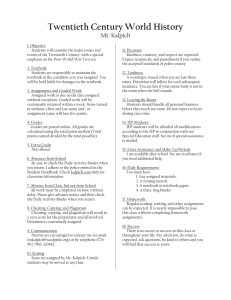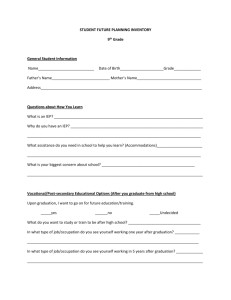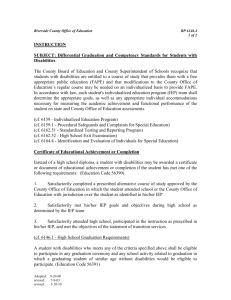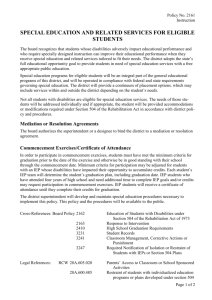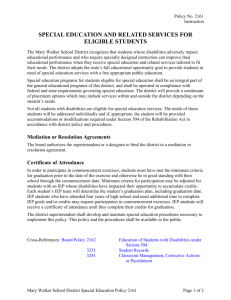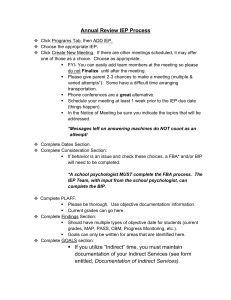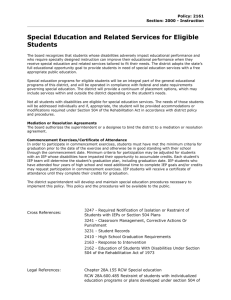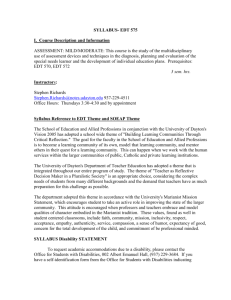High School vs. College Transition Programming
advertisement
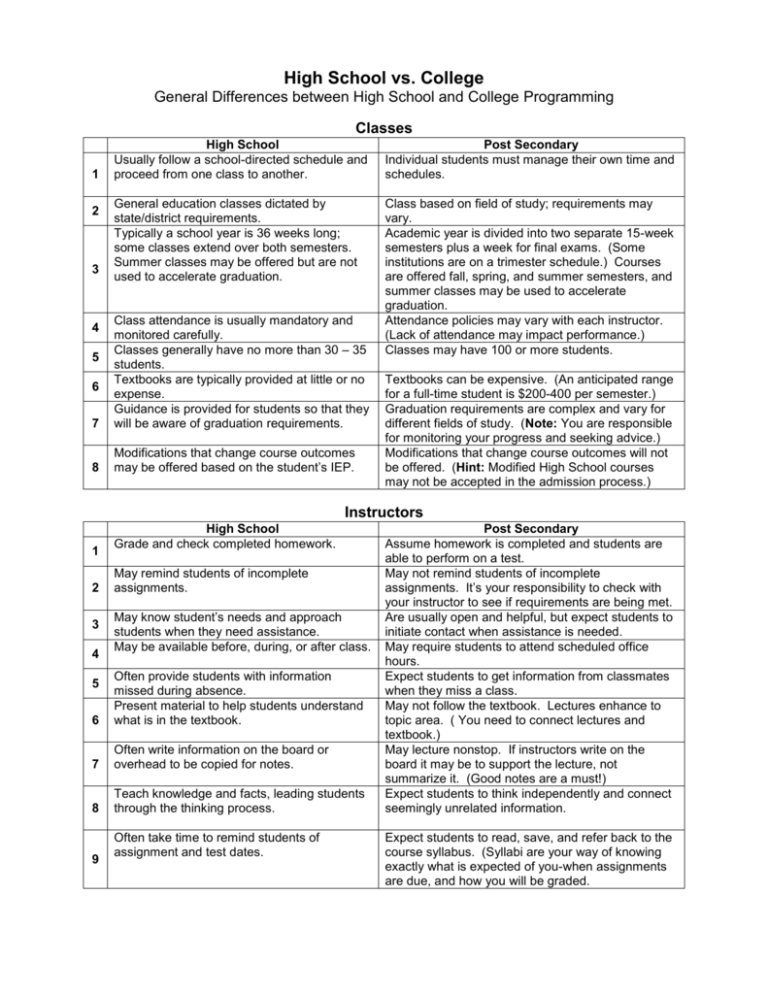
High School vs. College General Differences between High School and College Programming Classes 1 2 3 High School Usually follow a school-directed schedule and proceed from one class to another. Post Secondary Individual students must manage their own time and schedules. General education classes dictated by state/district requirements. Typically a school year is 36 weeks long; some classes extend over both semesters. Summer classes may be offered but are not used to accelerate graduation. Class based on field of study; requirements may vary. Academic year is divided into two separate 15-week semesters plus a week for final exams. (Some institutions are on a trimester schedule.) Courses are offered fall, spring, and summer semesters, and summer classes may be used to accelerate graduation. Attendance policies may vary with each instructor. (Lack of attendance may impact performance.) Classes may have 100 or more students. 7 Class attendance is usually mandatory and monitored carefully. Classes generally have no more than 30 – 35 students. Textbooks are typically provided at little or no expense. Guidance is provided for students so that they will be aware of graduation requirements. 8 Modifications that change course outcomes may be offered based on the student’s IEP. 4 5 6 Textbooks can be expensive. (An anticipated range for a full-time student is $200-400 per semester.) Graduation requirements are complex and vary for different fields of study. (Note: You are responsible for monitoring your progress and seeking advice.) Modifications that change course outcomes will not be offered. (Hint: Modified High School courses may not be accepted in the admission process.) Instructors 1 2 3 4 High School Grade and check completed homework. May remind students of incomplete assignments. May know student’s needs and approach students when they need assistance. May be available before, during, or after class. 6 Often provide students with information missed during absence. Present material to help students understand what is in the textbook. 7 Often write information on the board or overhead to be copied for notes. 8 Teach knowledge and facts, leading students through the thinking process. 5 9 Often take time to remind students of assignment and test dates. Post Secondary Assume homework is completed and students are able to perform on a test. May not remind students of incomplete assignments. It’s your responsibility to check with your instructor to see if requirements are being met. Are usually open and helpful, but expect students to initiate contact when assistance is needed. May require students to attend scheduled office hours. Expect students to get information from classmates when they miss a class. May not follow the textbook. Lectures enhance to topic area. ( You need to connect lectures and textbook.) May lecture nonstop. If instructors write on the board it may be to support the lecture, not summarize it. (Good notes are a must!) Expect students to think independently and connect seemingly unrelated information. Expect students to read, save, and refer back to the course syllabus. (Syllabi are your way of knowing exactly what is expected of you-when assignments are due, and how you will be graded. 2 Studying 1 2 3 High School Study time outside of class may vary (maybe as little as 1-3 hours per class.) Instructors may review class notes and text material regularly for classes. Expected to read short assignments that are discussed and re-taught. Post Secondary Generally need to study at least 2-3 hours outside of class for each hour in class. Review class notes and text material regularly. (Use the time between classes carefully.) Substantial amounts of assigned reading and writing may not be directly addressed in class. ( It’s up to you to read and understand assigned material or access support.) Testing High School Frequent, veering small amounts of material. 1 2 3 4 Make-up tests are often available. Test dates can be arranged to avoid conflicts with other events. Frequently conducts review sessions emphasizing important concepts prior to tests. Post Secondary Usually infrequent (2-3 times a semester.) Maybe cumulative and cover large amounts of material. (You need to organize material to prepare for tests.) Some classes may require only papers and/or projects instead of tests. Make-up tests are seldom an option and may have to be requested. Usually, scheduled tests are without regard to other demands. Faculty rarely offer review sessions; if so, students are expected to be prepared and to be active participants. Grades 1 2 3 High School Given for most assigned work. Good homework grades may assist in raising over grade when test grades are lower. Extra credit options are often available. 4 Initial test grades, especially when low, may not have adverse effect on grade. 5 Graduation requirements may be met with a grade of D or higher. Post Secondary May not be provided for all assigned work. Tests and major papers provide the majority of the grade. Generally speaking, extra credit options are not used to raise a grade. Fist tests are often “wake up” calls to let you know what is expected. (Hint: Watch out! They may account for substantial part of your final grade. Contact instructor, academic advisor, or student accessibility personnel if you do poorly.) Requirements may be met only if the student’s average meets the departmental standards. (Generally a 2.0 or higher.) Laws and Responsibility Mild/Moderate 12/09 3 1 2 3 4 5 6 7 8 9 High School Individuals with Disabilities Act (IDEA) and Americans with Disabilities Act (ADA). Covers ages 3 – 21 or until regular High School diploma are met. Free, appropriate public education is mandatory. Districts are required to identify students with disabilities through free evaluation and the individualized education program (IEP) process. Students receive special education services to address needs based on an identified disability. Services may include specially designed instruction, modifications, and accommodations based on the IEP. Individual student needs based on the IEP may be addressed by program support for school personnel. Progress toward IEP goals is monitored and communicated to the parent(s) and the student. Schools assist in connecting the student with community support agencies if identified as a transition need according to the IEP. Post Secondary Section 504 and Americans with Disabilities Act (ADA). Covers students with disabilities regardless of age; schools may not discriminate in recruitment, admission, or after admission solely on the basis of a disability. Students decide to attend and will probably pay tuition. Student is responsible for revealing and providing current documentation of a disability. (Self Advocating is essential.) Formal special education services are not available. Reasonable accommodations and modifications may be made to provide equal access and participation. No formal program support for school personnel is provided. Students are required to monitor their own progress and communicated their needs to instructors. Students are responsible for making their own connections with community support agencies. Other Factors to Consider 1 2 3 High School State and/or district policies may determine eligibility for participation in extracurricular activities. Parents typically manage finances for schoolrelated activities. Parents and teachers may provide support and guidance in responsibilities and setting priorities. Post Secondary Post secondary institution policies may determine eligibility for participation in extracurricular activities. Students are responsible for money management of basic needs and extra spending money. (Outside jobs may be necessary and one more “activity” to consider for time management.) Students are responsible for setting their own priorities. Adapted from Grossmont College, San Diego Community College District, CA “Catching The Wave” 2009 Mild/Moderate 12/09
